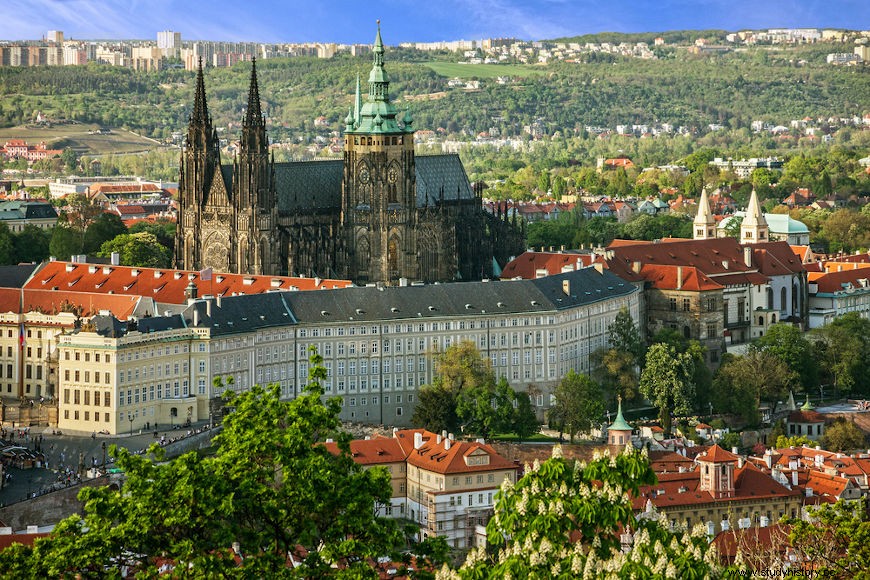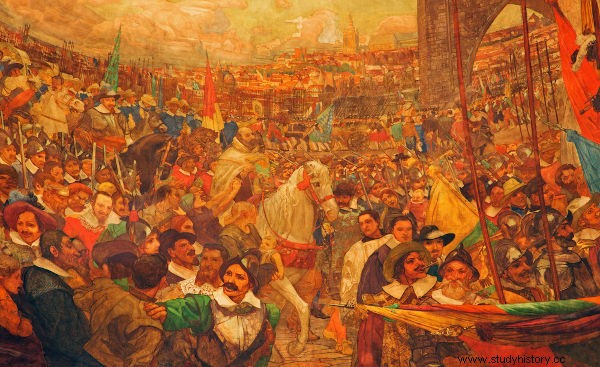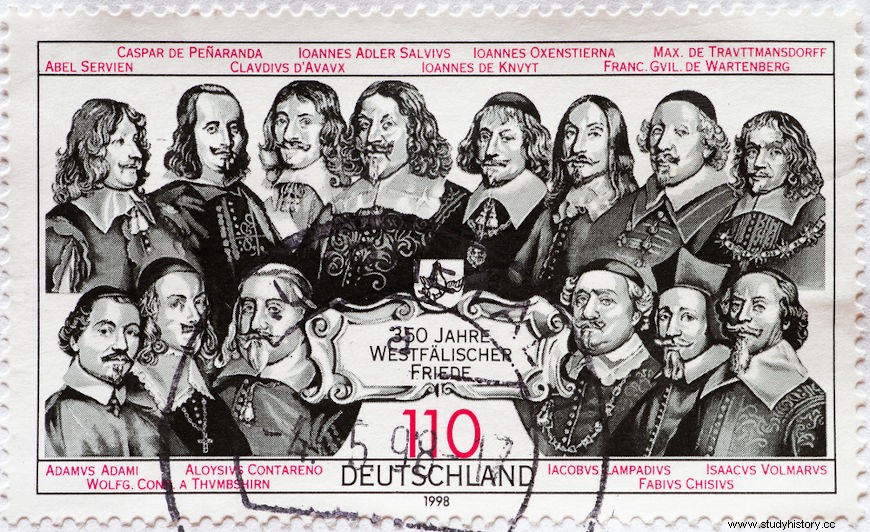The Thirty Years' War happened in Central Europe between 1618 and 1648, being, in European history, one of the highest mortality conflicts. Its initial motivation was the religious differences existing between Catholic and Protestant Christians, but it soon gained other contours.
Political motivations, which involved interests of territorial and economic expansion and even hegemony in Europe these became relevant issues and motivated a number of countries — such as France, the Netherlands, Denmark and Spain — to intervene in the conflict. The agreement that put an end to everything brought significant changes to Europe in posterity.
Login also :John Wyclif and Jan Hus - Luther's Forerunners in Europe
Motivation and trigger

In 17th century , there was in the German territory the existence of small kingdoms under the influence of the Holy Roman Empire. In addition to this political and territorial fragmentation , Germany had been the birthplace of religious conflicts that emerged with the Protestant Reformation.
These tensions emerged in the first half of the 16th century, lost strength in the second half of it, and were resumed from the beginning of the 17th century. A symbol of this moment of peaceful coexistence was the Peace of Augsburg , signed in 1555 and which aimed to put an end to conflicts between Protestants and Catholics in the territory of the Holy Empire.
However, during the reign of Rodolph II , tensions returned, mainly as the king tried to impose Catholicism force in his empire. Tensions ensued, and in the early 17th century, Protestants formed the Protestant Union , a group of cities whose interest was to defend their religious choice.
This action by Rudolph II was validated by the Peace of Augsburg, as it determined that a king could impose his religion on his kingdom. His action was still part of the interests of the Habsburg dynasty , defender of Catholicism and who ruled the Holy Empire. The persecution against Protestants continued to be carried out in the reign of Matthias, who took over after the death of Rudolph II.
This religious tension became very intense in some places of the Holy Empire, such as Bohemia (now Czechia). There, Protestants began to demand from Ferdinand II, King of Bohemia and future King of the Holy Empire, the right to profess their faith. Fernando II , a representative who was under the authority of Matthias and also a Catholic, rejected such requests.
Religious rivalry was fueled by the economic difficulties facing Bohemia, which made this kingdom a powder keg. On May 23, 1618, a group of noble Protestants adepts invaded Prague Castle to demand, from the emperor's representatives, the right to religious freedom.
The situation has worsened, and the Protestant nobles they ended up attacking the emperor's representatives and throwing them out of the castle's second-story window. This event became known as defenestration. from Prague . Then, the nobles of Bohemia announced that Ferdinand II was no longer the king of that kingdom, but Frederick V, a count who ruled the Palatinate, one of the regions that formed the Holy Empire.
This event started the first phase of the Thirty Years' War . At that time, the war was an internal event related to the religious and power disputes within the Holy Roman Empire.
Stages of War
The Thirty Years' War, as its name suggests, spanned three decades, beginning in 1618 and ending in 1648 . This conflict was initiated by religious disputes, within the Holy Empire, between Protestants and Catholics, but, over the years, the dispute expanded, gaining other motivations and counting on the participation of foreign forces.
Over these thirty years, historians have divided the conflict into four phases , which are:
-
Palatine-Bohemian Period (1618-1624)
-
Danish Period (1624-1629)
-
Swedish period (1630-1635)
-
French period (1635-1648)
-
Palatine-Bohemian period

This phase of the war, as we have seen, began when the Bohemian nobles rebelled against the authority of Ferdinand II. The rebels announced in 1619 that Frederick V was the new king . In addition, there was a union of the regions of Bohemia, Moravia and Silesia against the authority of the Holy Empire.
These acts started the Thirty Years' War. Ferdinand II, who had just been elected Holy Roman Emperor, declared war on the rebels. Foreign nations offered support to Bohemian Protestants, but internal dissent between Lutherans and Calvinists caused this group to weaken.
Thus, in November 1620, the Protestants were defeated by the Catholics, led by Johan t'Serclaes Graaf van Tilly, in the Battle of White Mountain. Protestants were then overthrown from power in Bohemia, many were killed, their properties were taken, Protestantism was banned in the regions under the Holy Empire, and the Bohemian throne came to be held hereditary by the Habsburgs.
After this victory, the Catholics of the Holy Empire, supported by Spain and Bavaria, went on the offensive and launched an attack against the Palatinate , a region still in Protestant hands. Frederick V was definitively expelled, taking shelter in The Hague, in the Netherlands. After the conquest of the Palatinate, the government of that region was given to Maximilian I , Catholic and ally of the Holy Empire.
-
Danish period
This period marks the internationalization of the conflict because the Catholic expansion promoted by the Holy Empire in Protestant territories, such as the Palatinate, drew the attention of some Protestant countries, such as the United Provinces, Denmark and Sweden. France also warned about the scenario, but for other reasons.
France feared the strengthening of the Habsburg dynasty , since they ruled over Spain and the Holy Empire. So the French began to fund Protestant groups so that they would engage in the fight against the Catholics of the Holy Empire, and the objective of this was to promote the weakening of that dynasty. The Danish king, Christian IV, financed by France, decided to enter the conflict to defend the Protestants.
The Danish intervention failed , and Emperor Ferdinand II decided to go even further against Protestant interests, determining that lands taken by them after 1555 would be returned to Catholics. The Danish king withdrew from the war through the Treaty of Lübeck , which ordered the maintenance of pre-war Danish borders and imposed that Denmark no longer intervened.
Login also :The invention of printing – understand the importance of printing for Europe
-
Swedish period
From 1630, the Swedes entered the conflict , also through an incentive given by the French. The Swedish troops that invaded the Holy Empire were led by the Swedish king himself, named Gustavo Adolfo . The Swedes came to the rescue of the Protestants through the invasion of Pomerania .
The Swedish advance was successful until 1632, but everything changed when Gustavus Adolphus was killed in the Battle of Lützen . His successors in command failed to play good roles in the war, and the Swedes were progressively defeated. With this failure, an agreement between Protestants and Catholics was reached, but it did not satisfy France, which finally decided to intervene in the war.
-
French period
The French feared the advance of the Holy Empire and the Spaniards in the conflict and, despite being Catholics, they decided to send their troops to war in defense of the Protestants. It was an action of geopolitical strategy , since the French knew that the defeat of the Habsburgs would benefit France, which would place itself as a European power, and this would allow it to gain new territorial conquests.
The French invasion, which began in 1635, had the support of the Netherlands, Sweden and Germanic Protestants . The French King Louis XIII managed to mobilize a troop of more than 120,000 soldiers. The Swedish and French forces managed, together, to wear down the Catholic troops of Germans and Spaniards.
The Holy Empire, ruled by Ferdinand III, pressured and suffering the impact of defeats on the battlefield, decided to open negotiations with the French and Protestants for peace from 1645 onwards. The Holy Empire suffered further defeats in the period 1645-1648, and the Germanic king was forced to yield , on its terms, and from there the Peace of Westphalia was issued, October 24, 1648.
Peace of Westphalia

The peace of Westphalia brought about profound transformations in the Europe from a territorial and international relations point of view . First, the big winners were France and Sweden , therefore, the two obtained important territorial gains. France took Roussillon from Spain, and from the Holy Empire, obtained Alsace and Lorraine.
The Swedes, in turn, stayed with Pomerania and received financial compensation. The Holy Empire was obliged to give independence to Switzerland , and the Spaniards were forced to give independence to the Netherlands . Eventually, the powers of the Holy Empire and Spain were drastically reduced, and France began its period of hegemony in Europe.
In the field of international relations, the Peace of Westphalia was an innovative feat, since it marked the weakening of religious affairs in matters involving the interests of the State . As a result, secular interests became the main defining factor for the conduct of the foreign policy of European nations.
Finally, on the religious side, Calvinism gained traction , having its right recognized as a Christian religion. Thus, a place's religion would be defined by its own king, regardless of whether he was Catholic, Lutheran, or Calvinist. Anyone who didn't agree with the king's religion should move.
Login also :What Changed in Europe After Napoleon's Defeat
Dead

The Thirty Years' War was one of the most violent of European history. During its extension, many of the nations involved assembled their troops with soldiers mercenaries , who took their pay from the plunder of war. Thus, the fighting soldiers showed no mercy to the local populations.
Men, women and children were killed by troops fighting in Germanic territory. Crops and villages were decimated, plague spread across the Holy Empire, and at the end of 30 years, it is estimated that the death toll was four million . Some statistics point out that this number may have been eight million, and others even speak of 15 million deaths.
The Holy Empire was torn apart, suffering from a severe population reduction and severe economic problems caused by the destruction of the war.
Image credits
[1] Renata Sedmakova and Shutterstock
[2] zabanski and Shutterstock
